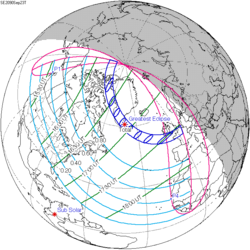| Annular eclipse | |
| Gamma | 0.3597 |
|---|---|
| Magnitude | 0.9262 |
| Maximum eclipse | |
| Duration | 536 s (8 min 56 s) |
| Coordinates | 7°00′N69°42′E / 7°N 69.7°E |
| Max. width of band | 295 km (183 mi) |
| Times (UTC) | |
| Greatest eclipse | 7:00:23 |
| References | |
| Saros | 141 (26 of 70) |
| Catalog # (SE5000) | 9650 |
An annular solar eclipse will occur at the Moon's ascending node of orbit on Sunday, February 17, 2064, [1] with a magnitude of 0.9262. A solar eclipse occurs when the Moon passes between Earth and the Sun, thereby totally or partly obscuring the image of the Sun for a viewer on Earth. An annular solar eclipse occurs when the Moon's apparent diameter is smaller than the Sun's, blocking most of the Sun's light and causing the Sun to look like an annulus (ring). An annular eclipse appears as a partial eclipse over a region of the Earth thousands of kilometres wide. Occurring about 2.5 days before apogee (on February 15, 2064, at 18:40 UTC), the Moon's apparent diameter will be smaller. [2]
Contents
- Eclipse details
- Eclipse season
- Related eclipses
- Eclipses in 2064
- Metonic
- Tzolkinex
- Half-Saros
- Tritos
- Solar Saros 141
- Inex
- Triad
- Solar eclipses of 2062–2065
- Saros 141
- Metonic series
- Tritos series
- Inex series
- References
- External links
The path of annularity will be visible from parts of southeastern Congo, northern Angola, the Democratic Republic of the Congo, extreme northern Zambia, Tanzania, the Seychelles, India, Nepal, northwestern Bangladesh, Bhutan, and China. A partial solar eclipse will also be visible for most of Africa and Asia.





































































































